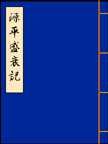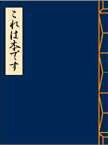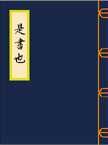Japanese books are unlike any others, with the possible exception of the handful of Chinese books that were the model for some of the binding forms. The first point, of course, is that to the Western reader, they are all backwards, as Japanese book front covers are what we would consider to be the back cover. (This is no problem: those reconstructing books are free to reverse this.)
The first books that existed in Japan were called kansubon, or rolled books (what we commonly call “scrolls”). These were in use prior to the ninth century, and though supplanted by later, more efficient forms, they were never fully replaced. Today they remain an art medium. Their largest problem is that they were bulky, difficult to store, and difficult to consult when a certain passage is being sought.
Kansubon were followed by the orihon, or folded book. The orihon was a single long sheet of paper (or, more commonly, several sheets pasted together) that was folded, accordion-style, and finished with a single panel cover on the top and bottom. This type of “binding” allowed for the simultaneous folding and unfolding of the book as reading progressed. These books are still used and favored for Buddhist texts and some musical notation, as they are space-conservative, and easy to read, and they stay open flat.
The senpuyo (flutter book) is a development of the orihon. Instead of a single panel cover on both front and back as with the orihon, the senpuyo has one cover with a spine, like a normal book. As the pages are only connected to the cover at the very front and back, however, the entire text could come fluttering out if one dropped an orihon, making a long circle of text and cover. This type of book appeared in the eleventh century.
In the twelfth century, a new book style, called the detchōsō (butterfly book) appeared. In this style, the first truly bound book where the leaves of text were attached to spine and cover. Sheets of standard size were folded in half with the text on the inside of the fold, then pasted together for c. 5 mm along the folds on the unprinted sides at the spine. As opposed to long strips that were either folded concertina-style (orihon and senpuyo) or rolled (kansubon), this was a solid book with all the pages permanently affixed in place. The problem the binding presented, however, was that every other spread was blank. This was offset, however, in the dual benefit that any text spread would open flat and not close, and that since the paper was so thin, there was no bleed-through of ink. Below is an example of a detchōsō edition of the Kokinshū poetry anthology from the mid-Muromachi period (c. late 15th c.).
The fukuro-toji (pouch binding) is a development of the detchōsō. Like the detchōsō, the pages with text are folded in half, but unlike the detchōsō, the text here is on the outside of the fold, resulting in the blank side of the sheets being on the inside, between the folded text. The leaves are gathered, stacked, and inserted between a separate back and front cover. When one opens such a book, there are no blank spaces, as there is printing on “both sides” of the leaf. This form of book, too, came from China, and appeared in Japan about the fourteenth century.
Fukuro-toji were usually bound in patterns with four or five holes. Four holes is the Chinese pattern, five the Korean model. Fukuro-toji—in all variations—is now generally considered the representative Japanese binding. It is used for albums poetry collections, diaries, and other artistic purposes today.
There were many different names used for this binding, depending on the pattern of threads used to tie the book together. The illustrations above show four common types, all of which are clear variations on the same theme. The ones on the right require more holes, and more sewing—but in addition to taking more time, they are more solid and look more impressive.
As in Europe, monasteries were the centers of book production and accumulation. Paper was expensive, and few people would have had the inclination to fund a printing house. Monasteries, as centers of learning and wealth, could do so. Buddhist texts printed by woodblocks in Japan in the eighth century are among the oldest printed documents in the world.
There were several standard sizes for Japanese books, depending on the cut of the sheet being used and the needs of the maker or buyer. The most common were the Mino book (7 7/8 x 11 inches) and its half size, the chūhon (5 1/2 x 7 7/8 inches); the hanshi (6 1/2 x 9 1/4 inches) and its half size, the kohon (4 5/8 x 6 1/2 inches); and the makurabon (7 7/8 x 5 1/2 inches). The makurabon (literally “pillow book”) was so called as it was sized to be able to fit into the wooden, box-like Japanese pillows, and was ideally suited for jotting random thoughts or keeping as a diary.
Construction of a fukuro-toji hon
There are many variations of binding under the heading fukuro-toji. This particular version is the most common, and is called yotsume-toji (= four-eye binding) as it has four holes that are used for the binding process.
Needed
20 – 25 sheets of paper, folded in half
2 sheets of heavy, colored paper for the covers, half an inch beyond final page dimensions
2 strips of 1/2 x 3 inch paper for binding, or two staples
2 strips of 1 x 1/2 inch paper or cloth for spine-corner binding (optional)
1 strip of c. 1 x 4 inch paper for title band
several feet of binding cord (e.g., thick embroidery floss)
library paste
awl, icepick, or narrow nail for punching holes
wooden board to punch on
hammer or mallet
thick, curved sewing needle
Process
Let us assume that we will make a fukuro-toji book with a four-hole binding of the dimensions 5 1/2 x 8 1/2 inches. This will allow us to take normal typing paper and use it as our raw material. You may either leave the pages blank or have a “border matrix” printed or photo-copied on it.
This matrix takes one of several forms, but it allows for a specific demarcation of where the text or illustrations will go. The simplest form of the matrix is just a box on each side of the fold in which all the text is written or illustrations placed. Japanese books traditionally don't have art spread straight across two pages; since the pages aren't made with spreads in mind, each side has its own blocked off area and “spreads” end on each side within the space of the matrix, continuing, if necessary, on the facing page within that page’s matrix. The second form has boxes with lines marked for text. Stationery stores in Japan sell these books in many sizes for people to write poetry or calligraphy, or even as a diary. The third type of matrix is typical for books that are actually being printed with a set text. The title of the book typically appears right at the fold, but it isn't legible due to the fold—it is only there to make it easy to keep track of sheets in a printing house working on a large print run. The three matrices are provided below for a letter-sized paper. Just click on any one of the thumbnails for a full-sized PDF that you can use. (The problem, of course, will be to find a printer that can print close enough to the edge of the paper.)
If you are using a matrix, print it out or photocopy it as many times as you need pages. You will need two extra blank pages as well—one for the front fly and one for the back. (Of course, you can use the blank matrix for these if you wish.) You should try to keep the number of sheets down to 20–25, or the book will be too thick. Most Japanese books, even relatively short ones, were divided into several volumes for this reason.
Fold all the sheets in half, printed side out. Remember that the top-most facing page and the bottom-most facing page will be glued into the covers, so they are blank. Stack them neatly, so that they are all oriented the same way.
Punch two pairs of small holes inside the dimensions for the cover binding. This is for the inner binding, to secure the pages. Binders usually used a strips of paper rolled into a “thread” and sewn through each pair and glued in, then flattened with a mallet. Modern binders may want to cheat (shhh!) and just use two staples. The effect, and overall idea, is the same—this is to just secure the pages so they don't shift or move about.
The cover material (usually either cloth or an ornate paper which has been glued to a heavy paper backing) is cut slightly larger than the book. Fold the top, bottom, and side ends of the cover back and into itself so that the cover has the same dimensions as the pages, and glue the folded edges down. This is to make the cover a bit stiffer around the edges and to help protect them. Glue the covers to the blank leading sheets, front and back.
Take a small strip of paper or fabric about an inch long and half as wide, and glue it to the bottom corner of the spine, and fold it over and glue it to the surface. (Think of the corner of sheets on a hospital bed.) Repeat for the head of the spine. This strip is an optional step, but it was designed to provide more strength to the book. Not all books were made with this reinforcing strip, as they were known to provide a dark and homey environment for book worms.
With a sharp, thick needle or narrow nail, punch the holes for the binding. Note that the binding holes are all equidistant from each other. The ends of the threads should be tucked up into the binding to be out of sight.
Now you are finished but for the application of a title strip. Take a piece of white or some pale, ornamental paper and cut it to an inch by four. Paste it vertically on the cover near the top and open edge of whichever you have decided is the front cover.
You now have a Japanese book.
Online resources
Washi. A source for washi (Japanese paper), including cover material for books.











